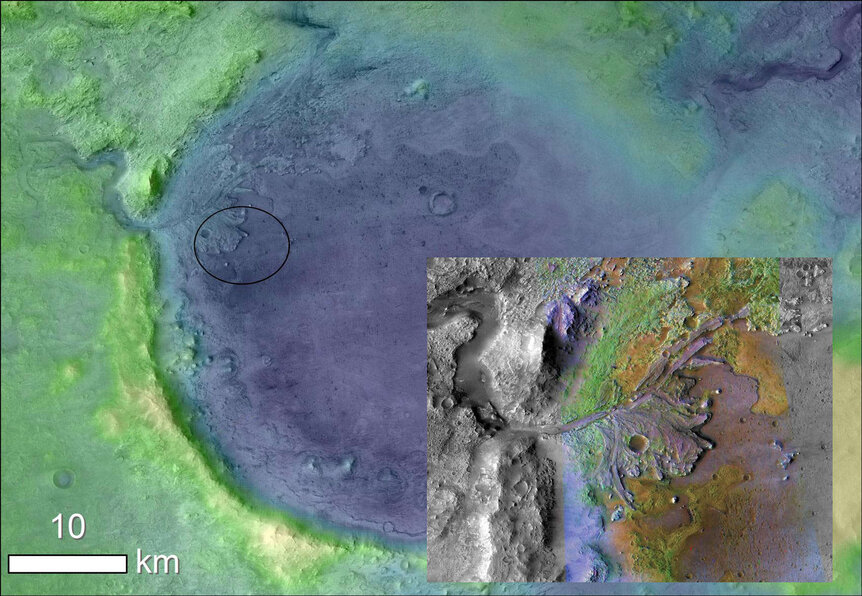Create a free profile to get unlimited access to exclusive videos, sweepstakes, and more!
Incredible video of a solar eclipse… from the surface of Mars!
Perseverance rover sees Phobos transiting the Sun.

Look up - Look down
Look out - Look around
Look up - Look down
There's a crazy world outside
-Yes, “It Can Happen”
Mars has two moons, Deimos and Phobos — Greek for “terror” and “fear”, apropos for the planet named after the god of war — which are small, lumpy spuds of rock.
Phobos is about 25 kilometers across, and on a very low orbit around Mars — it’s just 6,000 kilometers above the surface. So even though it’s tiny, it can appear as large as 0.25° across, half the size of the full Moon seen from Earth.
If you’re on the right spot on Mars, Phobos can sometimes pass directly in front of the Sun, making an eclipse — technically a transit, when an object cannot cover the background object completely. Even from the greater distance of Mars, the Sun is still roughly 0.3° across, so Phobos can’t block it completely.
But when it does transit the Sun, it makes for very cool images.
And video. The Perseverance rover, sojourning around Jezero crater on Mars, caught the fearful moon transiting the Sun on April 2, 2022. It took so many images they could be stitched together into a video, and, well, oh my. It’s really dramatic:
WHOA. The video has been created to show what Perseverance saw in real-time; the actual transit lasts about 35 seconds. It’s the highest resolution and highest frame-rate video ever taken of such an event from Mars.
You can see how lumpy Phobos is — at the leading end, see that dip? That’s the crater Stickney, which is 9 km across, huge compared to the moon itself.
You can also see sunspots! Judging from images of the Sun taken closer to Earth that day, I think those are active regions 2975 and 2976. Pretty cool.
Transits like this have been seen many times by rovers; they sometimes take images of the Sun to judge atmospheric transparency, which is an issue on the dust-laden Red Planet. A funny thing about the geometry: Earth’s Moon is so far from us that essentially anyone on the side of the Earth facing it can see it, and it appears roughly the same size for any observer. But Phobos orbits so close to Mars that when it rises it’s much farther away than when it’s directly overhead, so its size changes considerably as it crosses the sky. That means how big it appears during the transit depends on where in the sky the Sun and Phobos are, which means the transit can look very different in the morning or evening versus noon. At the latter, when the Sun is overhead, Phobos is at its closest and can nearly cover the Sun.
This also means that the track of Phobos’s shadow on the ground is really narrow, and if you’re at too high a latitude you’ll never see one. In fact, if you’re north of about 70° N or south of 70° S on Mars you can’t even see Phobos at all. It’s always below your horizon.
We have it pretty good here on Earth.
Another cool tidbit — literally cool: The Mars InSight lander has a seismograph on board, and kept registering a very slight shift in the tilt of the Martian surface around the lander during Phobos transits of the Sun. This is likely due to the moon blocking enough sunlight to cool the surface in its shadow. As the shadow of the moon passes the lander the ground contracts a little bit where it’s cooler, tilting the surface a very wee amount. This affect was only seen when the Sun was close to overhead, when heating and cooling were maximized. That’s amazing.
The Perseverance rover is designed to examine Jezero crater — known to have once been a lake eons ago — and look for conditions on Mars that are now or were once habitable. Did microscopic beasties once wiggle around on Mars?
On April 13, 2022 this search started a new phase I’m excited about: The rover reached a huge delta on the northwest side of Jezero, what is clearly sediment deposited by a river flowing into the crater billions of years ago. If life existed back then, or there were biological precursors of life, then that delta is an excellent place to look for it.
Perseverance is looking around and looking down, searching for life, but it can also look up and see what wondrous things happen above it, too. It has no capacity for awe or beauty, but we do, and it thrills me that we can send our proxies to other worlds so they can share their spectacular views and findings with us.




























